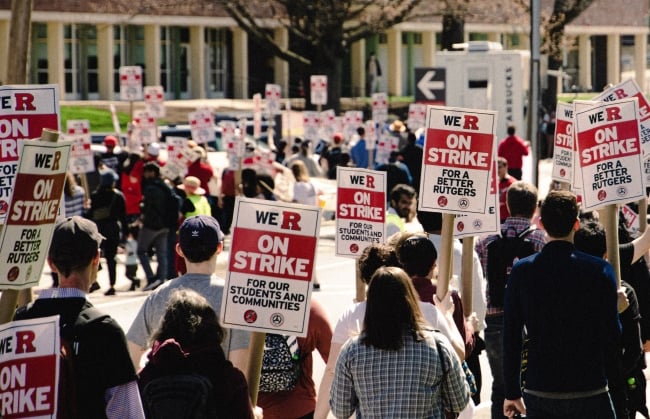You have /5 articles left.
Sign up for a free account or log in.

Rutgers University workers went on strike last spring.
It’s a boom time for higher education organizing. Last year alone, 26 new bargaining units representing over 40,000 graduate student workers, postdoctoral workers or researchers earned certification or voluntary recognition, according to the National Center for the Study of Collective Bargaining in Higher Education and the Professions (National Center). Strikes also increased and came to large universities such as Rutgers, which had its first faculty strike in its over 250-year history.
But there are major obstacles to further increasing solidarity: higher education workers are fragmented, and many lack collective bargaining rights. And this divided group is facing problems nationally, including funding challenges, a shift from tenure-track to contingent labor, and threats to academic freedom and other rights.
Now a developing organization, Higher Ed Labor United, or HELU, is seeking to forge a national coalition of all types of higher education workers—regardless of which union they’re in or whether they’re in any union, and regardless of their job title.
Joe Berry, a labor historian and longtime contingent faculty member who was among the founders of the Chicago Coalition of Contingent Academic Labor, is on the group’s interim steering committee. HELU isn’t a union itself; Berry said it aims to be a political voice, lobbying and supporting and opposing candidates for office at a national level. He said it also intends to be a think tank for higher education labor and a vehicle for informing and supporting workers across unions and universities to help them organize, bargain and take other action.
About 20 states don’t offer collective bargaining rights to any public college or university workers, and the ones that do don’t necessarily offer that right to all such employees, according to the National Center, which is housed at the City University of New York’s Hunter College. Federal law allows private institution employees to unionize—except, generally, tenured and tenure-track faculty members.
Of the employees who can collectively bargain, even those who are members of unions within the national AFL-CIO umbrella labor organization are divided among different bargaining units based on their job classifications. Those units negotiate different contracts with different universities in different states, where they deal with different laws and budget situations.
“When we are organized along job category, it makes it very easy for management to divide us,” said Todd Wolfson, president of Rutgers AAUP-AFT (American Association of University Professors-American Federation of Teachers). Higher education workers and students are facing problems with contingent labor conditions, government divestment in universities, student debt, a business-sector–aligned bureaucratic managerial class and a rising “proto-fascist right,” he said, and workers will only be able to address these things “if we align ourselves collectively.”
Wolfson has already engaged in some collective action. His union represents the faculty members, grad workers and other Rutgers employees who walked off the job last spring. But he’s also interim chair of HELU.
The effort’s interim vice chair also has strike cred: Rafael Jaime, president of the UAW local representing the University of California teaching assistants, tutors and readers who staged the massive 2022 strike across the UC system.
Berry said, “We need an ongoing coalition because there’s 13 different unions that represent people in higher education and they don’t talk to each other for the most part, they don’t speak with one voice on behalf of higher education labor,” and they don’t sufficiently help people work together outside of their own union.
Higher education workers make up fewer than a quarter of workers represented in most national unions, Berry said, “so we’re not the center of the plate and that’s a problem.” Also, he noted that many of the important higher education unions aren’t part of the AFL-CIO, so simply working through it would exclude many employees.
“Higher ed labor has punched way below its weight” considering its number of workers and economic importance, he said, “because it’s been so divided in many ways, and we need a higher ed labor movement which none of the individual unions are in a position to build.”
Rutgers at New Brunswick will host HELU’s founding convention in May—part of the group’s move from “an informal network” to “a formalized structure,” Wolfson said. Berry said HELU plans to elect officers and adopt a constitution and vision statement.
“We envision a future in which higher education is treated and funded as a social good and universal right,” the current draft of that statement says. “We envision a U.S. higher education system that works for and is led by workers, students and the communities it serves. We envision a system that secures our nation’s democratic future and serves as a vehicle for addressing inequities.”
The statement is ambitious. It calls for “coordinated nationwide action to move the federal government” to take several steps. The first: “establish the right to a quality, debtless, universally accessible and secure higher education,” including “mandates to increase access and retention for people historically or presently excluded.” Student workers are among those HELU includes in its coalition.
HELU’s second national call is for “fair terms and safe work conditions, living wages and steady careers,” for higher ed workers. The third and fourth are for all workers to have the right to unionize and for national reinvestment in higher education. The statement includes other goals; on tenure, for example, it proposes a national push to “move rapidly and at scale” to create an instructional workforce where the “supermajority” is full time and on the tenure track.
HELU’s website says the statement has been endorsed by more than 100 local unions and organizations representing more than 556,000 workers.
Berry said the push for HELU came out of excitement surrounding Senator Bernie Sanders’s 2016 and 2020 presidential campaigns, in which he called for free college, and from Joe Biden’s election, which he said suggested a chance for positive change instead of just playing defense against the Trump administration. He said the push also emerged from pandemic-related issues—workers fought against layoffs, budget cuts and other issues.
He said Scholars for a New Deal for Higher Education, a group of academics pushing for increased federal funding for nonelite colleges and universities, and organizers of what would become HELU, called for an online summit in the summer of 2021, and hundreds of people took part, representing over 100 local unions. Berry said HELU was born then.
It has held events since then, but it’s now seeking to rev up operations. Wolfson said many unions are paying “solidarity pledges,” which make up HELU’s primary funding.
While there have been major local union wins in the past couple of years, national organizing is still nascent. Many people involved in HELU have had to focus on winning their own strikes, said Trent McDonald, a Rutgers AAUP staff organizer who sits on HELU’s interim steering committee. “Now that a lot of those big contracts are settled, now is the time that people want to really double down and do the wall-to-wall, coast-to-coast organizing” of HELU, McDonald said. “Local fights ended up taking precedence, even if they are part of a larger, politicized national process.”
McDonald said narrow “craft unionism,” where workers are divided by what they do, doesn’t work in higher education. He said “the joint strategy of coordinated bargaining, action, organizing—and up to and including striking—that’s what’s necessary.”
Ariana Jacob, a part-time faculty member at Portland State University who is the bargaining chair for its part-time faculty union and leads the broader Oregon-AFT, is also on HELU’s steering committee. She said higher education’s problems can’t be solved at an institution-by-institution level.
“It makes doing the work at your one little institutional level where change comes at such a slow place, it makes it possible to see the light at the end of the tunnel,” Jacob said of HELU. “Basically it makes it possible to see how we could actually get real transformative change to happen in higher education.”








